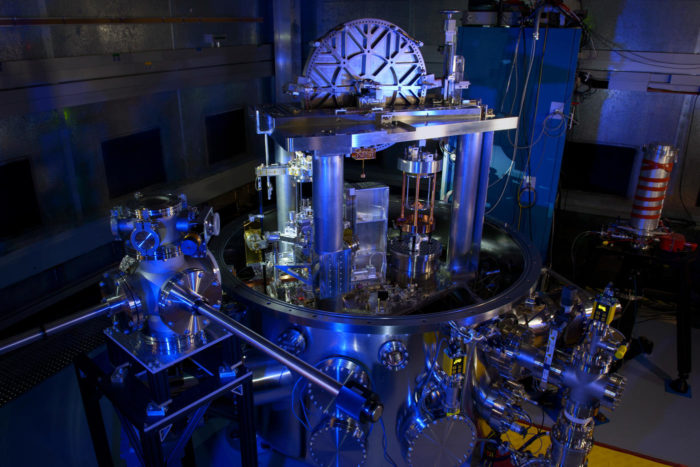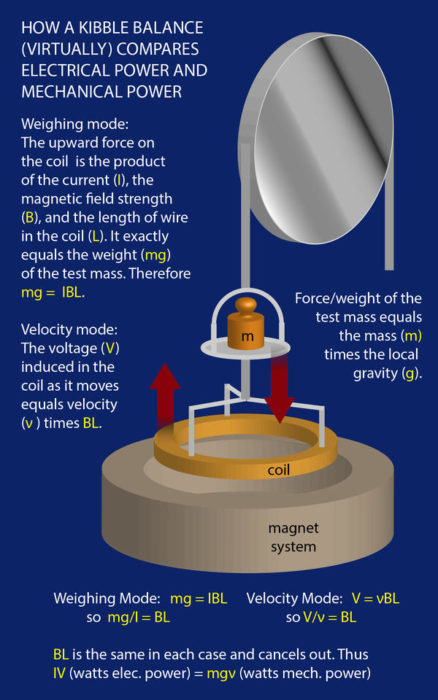Nov 16 2018
Changing the Kilogram
 This is one of those items that at first does not seem like a big deal, and probably won’t get much play in the mainstream media, but is actually a significant milestone. Today, the international General Conference on Weights and Measures will meet in Versailles, France, to vote on whether or not to adopt a new standard for the kilogram. This is a formality, because this change has been worked on for years and the standard is now all set to change.
This is one of those items that at first does not seem like a big deal, and probably won’t get much play in the mainstream media, but is actually a significant milestone. Today, the international General Conference on Weights and Measures will meet in Versailles, France, to vote on whether or not to adopt a new standard for the kilogram. This is a formality, because this change has been worked on for years and the standard is now all set to change.
I have been reading a lot recently about the history of science and technology, and one common theme is that an important core feature of our modern society is infrastructure. If, for example, there were some sort of apocalypse, what would it take to reboot society? Theoretically, we would preserve much of our knowledge in books and would not have to start from scratch. The limiting factor would likely be infrastructure. Gasoline engines won out over electric engines for cars partly (and some believe primarily) because the infrastructure for distributing gasoline was put in place before the electrical infrastructure.
Science itself also has an infrastructure, which includes standard weights and measures. This sounds boring, but being able to precisely measure something, using standardized units that every scientist around the world can use, is critically important to both science and technology. Anything that makes doing science easier reduces the cost and increases the pace of science, with incredible downstream benefits.
In 1879 Le Grand K (or the International Prototype Kilogram – IPK) was created – this is a cylinder of platinum and iridium that is the ultimate reference for 1 kilogram. This hunk of metal is kept in a double bell jar, and never touched. Even a slight finger print would change how much it weighs. From this original kilogram, exact copies were made and distributed to countries to serve as their national standard. Occasionally these copies are sent back to France to compare to the original. These copies are then used to calibrate equipment used for precise measurement.
This system has worked for 139 years, but it has two major limitations. The first is that the reference is a physical object, which is not immutable. In fact over the decades the original and the copies have drifted out of alignment. The copies are now slightly heavier than the original, on average by about 50 micrograms. This is obviously a tiny amount, not critical for many bulk items like food, but critical if you are doing physics and dealing with small masses.
The second problem with the IPK is scaling. The IPK is, by definition, one kilogram. But what if you are trying to calibrate a scale that measures miligrams or micrograms, or at the other end of the scale thousands of kilograms? You have to go through a process to scale down or scale up your reference – use the IPK to calibrate a scale which is then used to measure a smaller or larger reference for a smaller or larger scale, until you get to the desired range.
The kilogram is actually the last standard measure that is based on a physical artifact. For example, the meter was also based on a platinum-iridium artifact – a bar of exactly one meter in length (by definition), with copies sent around the world for reference. However –
In 1960 the meter was redefined as 1,650,763.73 wavelengths of orange-red light, in a vacuum, produced by burning the element krypton (Kr-86). More recently (1984), the Geneva Conference on Weights and Measures has defined the meter as the distance light travels, in a vacuum, in 1/299,792,458 seconds with time measured by a cesium-133 atomic clock which emits pulses of radiation at very rapid, regular intervals.
Changing the meter to a physical property rather than an artifact allowed it to be duplicated more easily and precisely, and to scale up or down without limit. It has been 58 years since the meter got this upgrade, and the kilogram is long overdue. But how are we going to do it?
The basic physics is not that complicated, and it starts with Einstein and E=MC^2 – energy is equal to mass times the speed of light squared. We also need to add in Planck and his constant. Planck solved some problems with classic physics (such as the ultraviolet catastrophe) by realizing that energy is not infinitely divisible but comes in minimal packets or quanta. Planck equation is E=hv – energy equals the frequency of radiation times Planck’s constant.
 Therefore – MC^2 = hv, which means that if we can measure accurately the frequency of an object we would precisely know its weight. This is dependent on having a precise measure of Planck’s constant, which we now have. This was accomplished using a Kibble balance, which is that last piece of the kilogram puzzle. A Kibble balance uses electrical resistance to precisely measure mass, based on Planck’s equation. This is the part of the process I don’t fully understand, because it gets a bit wonky. The Kibble balance is based on the Josephson constant (KJ = 2e/h) and the von Klitzing constant (RK = h/e2). These relate electrical resistance to frequency. Basically it uses the force produced by a current-carrying wire in a magnetic field to balance the weight of a mass.
Therefore – MC^2 = hv, which means that if we can measure accurately the frequency of an object we would precisely know its weight. This is dependent on having a precise measure of Planck’s constant, which we now have. This was accomplished using a Kibble balance, which is that last piece of the kilogram puzzle. A Kibble balance uses electrical resistance to precisely measure mass, based on Planck’s equation. This is the part of the process I don’t fully understand, because it gets a bit wonky. The Kibble balance is based on the Josephson constant (KJ = 2e/h) and the von Klitzing constant (RK = h/e2). These relate electrical resistance to frequency. Basically it uses the force produced by a current-carrying wire in a magnetic field to balance the weight of a mass.
So – Kibble balances (there are about 6 in the world) can be used to precisely measure Planck’s constant from a known reference mass, like the IPK. Now that we have an accurate measure of h, a precise value is taken as a given, and the process can be reversed to measure an unknown mass.
So now the standard kilogram can be referenced with a number, rather than a physical artifact. This makes it much easier to reproduce, and also it can be infinitely scaled. You can use the reference to measure a microgram or a megagram directly.
This is an important step in advancing the infrastructure of science and technology. The IPK, after today, will likely be relegated to an historical artifact.






